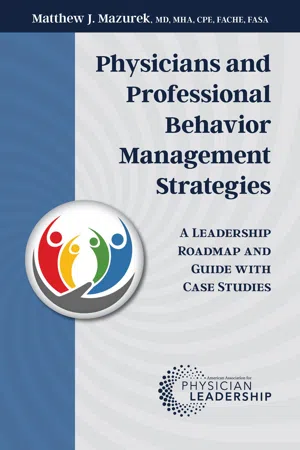
Physicians and Professional Behavior Management Strategies
A Leadership Roadmap and Guide with Case Studies
- English
- ePUB (mobile friendly)
- Available on iOS & Android
Physicians and Professional Behavior Management Strategies
A Leadership Roadmap and Guide with Case Studies
About This Book
One of the most difficult tasks physician leaders regularly face is managing and mitigating unprofessional physician conduct complaints from patients, colleagues, nurses, and staff. Navigating the process well is usually a trial-by-fire exercise for most. Newly appointed physician leaders, especially, are nervous and uncomfortable confronting these issues with their colleagues.
Physicians and Professional Behavior Management Strategies aims to assuage those concerns and instill confidence by providing practical advice and guidance on managing disruptive behavior with real-world case examples and in-depth discussion on the process.
Case examples include:
- Sexual Harassment
- Physical Aggression
- Substance Abuse
- How to Have Difficult Conversations and Conduct Meetings with Proactive Follow Up
Complementing the case discussions are strategies to reduce and mitigate disruptive behavior.
Physician leaders often lack formal training on how to "manage" physicians engaged in unprofessional behavior.There are professional, personal, and legal pitfalls, and everyone engaged in the process is uncomfortable. Through Dr. Matthew Mazurek's leadership positions, he has had the opportunity to conduct dozens of investigations of unprofessional and disruptive conduct from the mundane to the serious.He offers practical advice and guidance on managing disruptive behavior, description and analysis of personal traits and disorders of disruptive physicians, and strategies to reduce the incidence of these behaviors.
The Joint Commission, recognizing the need for hospitals and medical staffs to intervene, released a statement on how disruptive behavior harmed patients and lead to medical errors.
Physicians and Professional Behavior Management Strategies through a variety of case examples, gives readers a roadmap on how to recognize and manage chronic disruptive behavior instead of looking the other way.
Frequently asked questions
Information
Chapter 1
History of Disruptive Behavior
- Veltman L. The Disruptive Physician: The Risk Manager’s Role. Journal of Healthcare Risk Management. 1995;15:11–16.
- Flexner A. Medical Education in the United States and Canada. Boston: Merrymount Press; 1910.
Chapter 2
Definition of Disruptive Behavior
Table of contents
- About the Author
- Acknowledgments
- Statement of Purpose, Mission, and Focus
- Introduction
- The Joint Commission Sentinel Event Alert 40: Behaviors That Undermine a Culture of Safety
- Chapter 1
- Chapter 2
- Chapter 3
- Chapter 4
- Chapter 5
- Chapter 6
- Chapter 7
- Chapter 8
- Chapter 9
- Chapter 10
- Chapter 11
- Chapter 12
- Chapter 13
- Chapter 14
- Appendix